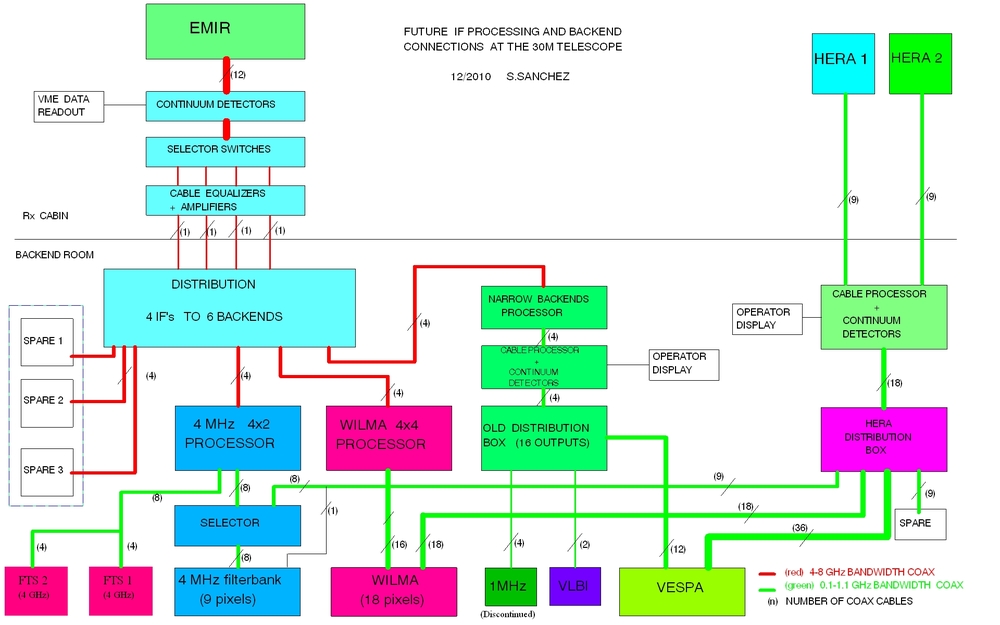|
Size: 4680
Comment:
|
Size: 4705
Comment:
|
| Deletions are marked like this. | Additions are marked like this. |
| Line 36: | Line 36: |
| 1. '''ABBA1 and ABBA2''' (Adc Bolometer Backend) are the bolometer backends, i.e. dedicated PCs connected to the bolometers. | 1. '''ABBA1 and ABBA2''' (Adc Bolometer Backend) are the bolometer backends for the MAMBO 1mm camera, i.e. dedicated PCs connected to the bolometers. |
Contents
Backends for EMIR, HERA, MAMBO (after EMIR installation & commissioning in March/April 2009)
|
Type |
Channel Width |
Bandwidth |
Receiver (width mode) |
Remark |
|
4 MHz |
Filterbanks |
4 MHz |
8 or 9 x 1GHz |
EMIR, either HERA1 or HERA2 (wide) |
|
(1) |
WILMA |
Autocorrelator |
2 MHz |
16 or 18 x 930 MHz |
EMIR, HERA (wide) |
|
(2) |
FTS |
FFTS |
195 kHz |
2x4 GHz |
EMIR |
|
(4.1) |
FTS |
FFTS |
195 kHz |
8x4 GHz |
EMIR, HERA |
|
(4.2) |
FTS |
FFTS |
50 kHz |
|
EMIR, HERA |
|
(4.3) |
VESPA |
Autocorrelator |
3.3 kHz-1.25 MHz |
10-512 MHz |
EMIR, HERA (narrow) |
|
(5) |
XPOL |
VESPA |
40kHz-1.25MHz |
120-640MHz |
EMIR |
|
(6) |
ABBA2 |
|
|
|
MAMBO2 |
|
(7) |
nbc / continuum |
continuum |
1 GHz |
|
|
|
(8) |
bbc |
continuum |
8 GHz |
|
|
|
(9) |
See here, for the present status of the backends. For more information on the capabilities of EMIR, see here. In general, several backends can be attached to one receiver. Exceptions are listed below. The pako manual describes in detail how to configure the backends.
4MHz Filterbank: max. 9 parts; use of the 4MHz filterbank excludes the use of VESPA on the same receiver. Frequency switching not available. While the channel spacing is 4MHz, the 3dB width is 5.4MHz and the noise equivalent width is 6.5 MHz
WILMA: The Wideband Line Multiple Autocorrelator for EMIR and HERA
1MHz Filterbank: max. 4 parts; series, parallel, or mixed mode possible; using the 1MHz filterbank with 1GHz bandwidth excludes the use of VESPA with the same receiver. The filterbank can be shifted in multiples of 32MHz from the center frequency of the connected receiver. Deactivated since 4/2008
Fast Fourier Transform Spectrometer (FTS): for the winter semester 2010/11 we offer 8 units covering 2x4GHz of bandwidth with a fixed resolution of 195kHz for EMIR. During July 2011, the FTS and the FTS are upgraded to 32GHz bandwidth with 195 resolution for EMIR and HERA. During this time, none of the FTS units will be available for observations. See the backend status page.
VESPA: The Versatile SPectrometer Array. Up to 18000 channels. In connection with HERA (9 pixels) the following combinations of resolution (kHz) and bandwidth (MHz) are possible: (20/40), (40,80), (80, 160), (320,320), (1250, 640); VESPA User Guide (2002), Summary in IRAM Newsletter No. 54 (Dec 2002), local contact: G. Paubert
XPOL: Line and continuum polarimetry is possible at the 30m using a new type of IF polarimeter designated XPOL. The central feature of XPOL is the correlator VESPA where the IF signals from two orthogonally polarized receivers are cross correlated to determine the four Stokes parameters. A manual is in preparation, contact: C. Thum
ABBA1 and ABBA2 (Adc Bolometer Backend) are the bolometer backends for the MAMBO 1mm camera, i.e. dedicated PCs connected to the bolometers.
Continuum backend with 1GHz width, is still the old system used for the ABCD receivers
Continuum backend with 8GHz width, fully exploiting the increased bandwidth of EMIR, is in preparation.
Distribution of intermediate frequencies (IFs) to the backends (Status: July 2011)
IF distribution in preparation for end of July 2011
Figure 2: Planned IF distribution for 2011
Old IF distribution (Status: June 2011)

Figure 1: IF distribution (16-Dec-2010 SS/CK)


